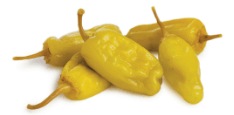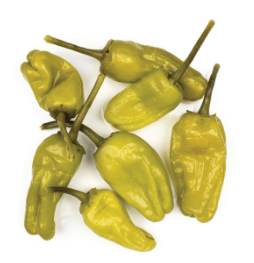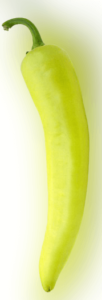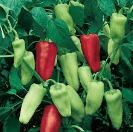What is a pepperoncini?

Pepperoncini peppers come from a plant known as Capsicum annuum.
Pepperoncini peppers are a type of mild chili pepper that is often used in Mediterranean and Italian cuisines. They’re known for their tangy, slightly sweet flavor and are usually pickled before consumption.
These peppers are typically green when fresh but can also turn red as they mature. They’re commonly used in salads, sandwiches, and as a garnish.
Pepperoncini peppers are not only delicious but also offer some health benefits. They’re low in calories, high in antioxidants, and can help with digestion due to their pickling process.
Pepperoncini peppers are versatile and can be used in a variety of dishes.
- Salads: Add sliced pepperoncini to salads for a zesty kick. They pair well with Greek salads, whose tanginess complements olives, feta cheese, and cucumbers.
- Sandwiches and Wraps: Pepperoncini peppers can be a great addition to sandwiches and wraps. They add a bit of crunch and heat without overwhelming the other flavors.
- Pizzas: Top your pizza with sliced pepperoncini for an extra layer of flavor. They work well with both classic toppings like pepperoni and more unconventional combinations.
- Pasta Dishes: Incorporate pepperoncini into pasta dishes, especially those with a Mediterranean flair. They can add a nice contrast to rich, creamy sauces or complement a simple olive oil and garlic dressing.
- Toppings: Use pepperoncini as a garnish for burgers, hot dogs, or grilled meats. Their tanginess can cut through the richness of the meat.
- Pickle Juices: The brine from pickled pepperoncini peppers can be used in salad dressings or as a marinade for meats and vegetables, adding a subtle tangy flavor.
- Relish: Chop pepperoncini and mix them with other ingredients like onions, garlic, and spices to make a tangy relish that can be served with grilled meats or used as a topping for tacos and burgers.
- Salsa: Blend pepperoncini into salsas or dips for a unique twist on traditional recipes. Their mild heat and pickled flavor can enhance the overall taste profile.
Are pepperoncini and banana peppers the same?
Pepperoncini peppers vs banana peppers
Pepperoncini peppers and banana peppers are often confused due to their similar appearance, but they have distinct differences in flavor, heat, and usage.
Pepperoncini Peppers
 Appearance: Pepperoncini peppers are usually small, wrinkled, and have a slightly curved shape. They are typically green when picked young but can turn red when fully ripe. They are often pickled before consumption.
Appearance: Pepperoncini peppers are usually small, wrinkled, and have a slightly curved shape. They are typically green when picked young but can turn red when fully ripe. They are often pickled before consumption.- Flavor: Pepperoncini peppers have a tangy, mildly sweet flavor with a subtle heat. The pickling process adds a sour note that enhances their flavor profile.
- Heat Level: They are relatively mild, generally ranging from 100 to 500 Scoville Heat Units (SHU). This makes them a good option for those who prefer a touch of heat without overwhelming spiciness.
- Usage: Pepperoncini peppers are commonly used in Mediterranean and Italian dishes. They are great in salads, sandwiches, pizzas, and as a condiment or garnish. The pickled version is also popular in antipasto platters.
Banana Peppers
 Appearance: Banana peppers are long and tapered, resembling the shape of a banana. They are smooth and can be yellow, green, or red, depending on their ripeness and variety.
Appearance: Banana peppers are long and tapered, resembling the shape of a banana. They are smooth and can be yellow, green, or red, depending on their ripeness and variety.- Flavor: Banana peppers have a mild, slightly tangy flavor with a hint of sweetness. They are not as sour as pickled pepperoncini but still have a pleasant tang when pickled.
- Heat Level: Banana peppers are also mild, typically ranging from 0 to 500 SHU. This makes them similar in heat to pepperoncini peppers but generally on the lower end of the scale.
- Usage: Banana peppers are versatile and can be used both fresh and pickled. They are popular in salads, sandwiches, pizzas, and as a topping for burgers. They’re also used in Southern and Tex-Mex cuisines.
What are pepperoncinis good for?
Nutritional Profile (per 100 grams)
- Calories: About 31 kcal
- Water: 92%
- Protein: 1 gram
- Fat: 0.2 grams
- Carbohydrates: 7 grams
- Fiber: 2.5 grams
- Sugars: 4 grams
- Vitamins:
- Vitamin C: Approximately 50 mg (around 55% of the daily recommended value)
- Vitamin A: About 900 IU (significant for maintaining healthy vision and skin)
- Vitamin K: A small amount, contributing to blood clotting and bone health
- Minerals:
- Potassium: Approximately 250 mg (important for heart health and fluid balance)
- Calcium: Around 10 mg
- Magnesium: Around 15 mg
- Iron: About 0.8 mg
Pepperoncini pepper health benefits
Pepperoncini peppers, often found in Mediterranean cuisine, have several potential health benefits:
- Rich in Nutrients: Pepperoncini peppers are a good source of vitamins A, C, and K, as well as minerals like potassium and calcium. These nutrients can support overall health, including immune function and bone health.
- Antioxidants: They contain antioxidants, which can help combat oxidative stress and reduce inflammation in the body. This may help in lowering the risk of chronic diseases.
- Digestive Health: The capsaicin in pepperoncini peppers can stimulate digestion and increase metabolism. This can aid in better digestion and potentially help with weight management.
- Anti-inflammatory Properties: Capsaicin also has anti-inflammatory properties, which might help reduce inflammation-related conditions.
- Blood Sugar Regulation: Some studies suggest that capsaicin might help regulate blood sugar levels, which could be beneficial for people with diabetes.
- Hydration: Being high in water content, they can contribute to your daily hydration needs.
- Pain Relief: Capsaicin is known for its potential in pain relief. It’s sometimes used in topical treatments for arthritis and muscle pain, though the effects when consumed may be less direct.
Pepperoncini pepper plant
Pepperoncini seedlings
 Timing:
Timing:-
- Indoor Starting: Start seeds indoors 8-10 weeks before your last expected frost. This gives seedlings enough time to develop before being moved outdoors.
- Materials:
-
- Seed Starting Mix: Use a light, well-draining seed starting mix.
- Seed Trays or Pots: Small pots, seed trays, or peat pots.
- Plastic Cover: To maintain humidity and warmth.
- Grow Lights: For consistent light if you don’t have a sunny window.
- Planting:
-
- Sow Seeds: Fill your seed trays or pots with seed starting mix. Sow the seeds about 1/4 inch deep.
- Watering: Water gently to moisten the soil. Keep the soil moist but not soggy.
- Cover: Cover with a plastic dome or plastic wrap to retain moisture and warmth.
- Germination:
-
- Temperature: Maintain a soil temperature of 70-85°F (21-29°C) for optimal germination.
- Light: Once seeds sprout, remove the cover and provide 12-16 hours of light per day using grow lights or a sunny window.
- Care:
-
- Watering: Keep the soil moist but avoid waterlogging. Water from the bottom to prevent fungal diseases.
- Fertilizing: Begin feeding with a diluted, balanced liquid fertilizer once seedlings have their first true leaves.
- Hardening Off:
-
- Acclimation: Gradually expose seedlings to outdoor conditions over 7-10 days before planting. Start with a few hours of morning sun and increase exposure gradually.
Planting Pepperoncini Seedlings Outdoors
- Preparation:
-
- Location: Choose a sunny spot with well-draining soil. Pepperoncini peppers need full sun to thrive.
- Soil: Amend the soil with compost or well-rotted manure to improve fertility and drainage. Aim for a soil pH of 6.0 to 6.8.
- Transplanting:
-
- Timing: Transplant seedlings outdoors after the last frost date when the soil temperature is consistently above 60°F (15°C).
- Spacing: Space seedlings 18-24 inches apart to provide adequate room for growth.
- Planting:
-
- Digging: Dig a hole slightly larger than the seedling’s root ball.
- Planting: Place the seedling in the hole, making sure the soil level of the seedling is even with the surrounding soil. Backfill with soil and water thoroughly.
- Ongoing Care:
-
- Watering: Water regularly to keep the soil evenly moist. Avoid overhead watering to reduce the risk of fungal diseases.
- Mulching: Apply mulch around the base of the plants to retain moisture and suppress weeds.
- Fertilizing: Feed with a balanced fertilizer or one high in phosphorus every few weeks to support fruit development.
- Supporting Plants:
-
- Staking: As plants grow and produce fruit, they may need staking or support to prevent them from toppling over.
- Pest and Disease Management:
-
- Monitoring: Regularly check for pests like aphids and spider mites, and signs of diseases such as blight and mildew.
- Treatment: Use organic or chemical treatments as necessary to manage pests and diseases.
Harvesting
- Timing: Pepperoncini peppers are typically harvested when green, about 60-70 days after planting. They can also be left on the plant to turn red if desired.
- Method: Use scissors or pruning shears to cut peppers from the plant, leaving a small stem to avoid damaging the plant.

 Appearance: Banana peppers are long and tapered, resembling the shape of a banana. They are smooth and can be yellow, green, or red, depending on their ripeness and variety.
Appearance: Banana peppers are long and tapered, resembling the shape of a banana. They are smooth and can be yellow, green, or red, depending on their ripeness and variety. Timing:
Timing: